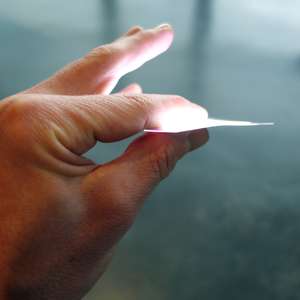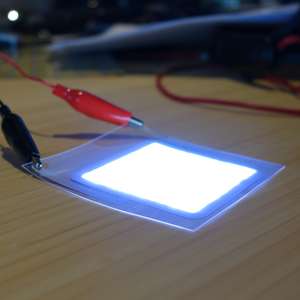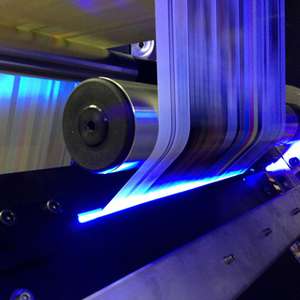November 30, 2014 weblog
Rohinni's Lightpaper invites innovative lighting

Rohinni's Twitter statement on what this company is all about is quite simple: We print light. Print light? This Coeur d'Alene, Idaho-based company is introducing its Lightpaper, with a promotional video which is asking the always-engaging "what if" question; in this instance, what if you had the ability to print light? In doing so, it would be "empowering you to create and innovate with light, in ways that were never before possible." Rohinni is introducing the world's thinnest LED lighting, according to the company, with an approach where one can apply it to nearly any surface, in any shape and for any situation.
Popular Science described Lightpaper as "a paper-thin light-emitting square. When a charge is sent through it, it glows like a gleaming portal." Last month, in CDAPress (The Coeur d' Alene Press), Nick Smoot, chief marketing officer, said the best way to describe Lightpaper was that it is "a mix of LEDs and ink. Using a proprietary process, that solution is printed on a substrate." He also stressed in that encounter that its application potential was endless, Smoot said they were thinking about printing lamp shades—the lamps would not need light bulbs. "Anywhere there is a light, this could replace that." He also said that eventually people will be able to print their own at home. "You will be able to design and print you own light," he said. "Right now we are printing the light, but we are going to be putting that back in the hands of the people."
Applications in mind? While their answer is "endless markets," limited only by the imagination, they give illustrated examples on their website. The technology could be illuminating logos on products, such as mobile phones, installing lighting on your wall, or a wearable wristband flashing the time and message notifications.
"With Lightpaper it's more of a platform of light that we don't even know how it's going to be used," said Smoot in Fast Company. "All we know is that we're trying to unlock the ability to create light."
Tyler Hayes in Fast Company wrote about their mixing ink and tiny LEDs together and printing them out on a conductive layer. "That object is then sandwiched between two other layers and sealed," he said. "The tiny diodes are about the size of a red blood cell, and randomly dispersed on the material. When current runs through the diodes, they light up." Smoot did not identify the companies by name, but said a few companies were already working on Lightpaper implementations, according to Hayes. Fast Company said that Lightpaper may be seen "in the wild" around the middle of next year. Before that, they are to work on a second version of Lightpaper, which Hayes said was likely a few months out. The challenge being worked on is to get specific placement of the diodes, to produce completely even light.
Philips, in discussing light emitting diodes (LEDs), said that "Once relegated to humble indicator lights in electronic devices," LED lights have advanced, enabling a new category of lighting projected to reach $30 billion by 2025. Philips pointed out that the structure of the LED light is completely different than that of the light bulb. "Amazingly, the LED has a simple and strong structure. The beauty of the structure is that it is designed to be versatile, allowing for assembly into many different shapes." Philips added that "Today is an exciting time for those working closely with LED lighting systems, which allow completely new uses of light."
More information: www.rohinni.com/#technology
© 2014 Tech Xplore





















